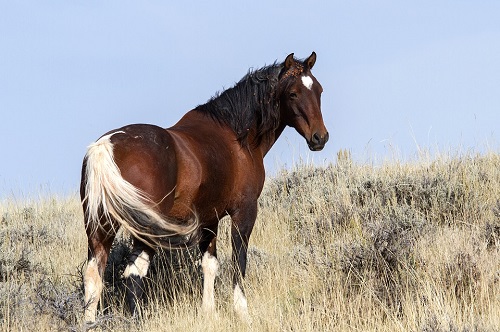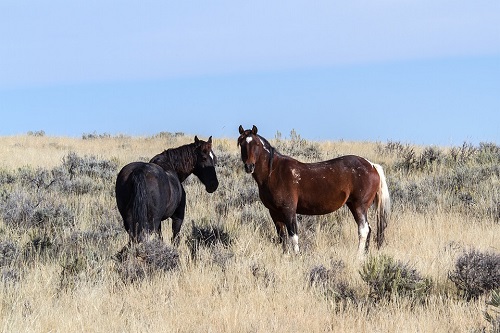Horses, Wild and Free - The Mustang Part 2
The dawning of the 20th century heralded changes that would directly impact the thousands of horses roaming free in America.
(Image by Klaus Stebani - Pixabay)
Large herds of horses didn’t pose much of a problem until the western United States became settled, introducing cattle and other grazing animals. Mainly arid, the lands in the west couldn’t support livestock as well as free-roaming horses so it became the policy to shoot mustangs. Another factor that saw the deterioration of the mustang population was the country’s involvement in the Spanish-American War of 1898 and the First World War, which saw countless of these horses rounded up for use.
At the beginning of the 20th century, the mustang population was estimated to be in the region of 2 million; by 1926, it had almost been halved.
But there were those who recognised the importance of these mustangs, many who still possessed the blood of their Spanish ancestors. One of these was Robert Brislawn who, along with his brother, Ferdinand, started efforts to preserve the disappearing original mustangs. In 1957, they and Lawrence Richards set up the Spanish Mustang Registry.
By the 1930s, the majority of free-roaming horses were mainly confined to public lands still being administered by the General Land Office (GLO). Created in 1812, the GLO was an independent government agency responsible for the country’s public domain lands. Public domain lands cannot be sold because they legally belong to the citizens of the country.
In the early 20th century, the GLO’s function altered to focus mainly on collecting grazing fees from those who raised their livestock on public lands and royalties from minerals withdrawn from those lands. Remember this little fact and ask yourself, with the majority of free-roaming horses living on those same public lands, how invested was the GLO in the horses’ conservation?
As more and more livestock were being raised on public lands, the Taylor Grazing Act established the United States Grazing Service in 1934. In 1946, the US Grazing Service was merged with the GLO to become the Bureau of Land Management (BLM). This agency is responsible for managing public lands still in federal ownership.
(Image by ‘mdimock’ - Pixabay)
By the 1950s, the mustang population had dropped to an estimated 25,000. This was mainly due to violent ill-treatment linked to some capture methods, like hunting from airplanes and poisoning their water holes.
Thanks to the heroic efforts of people like Velma Bronn Johnston, an animal rights activist also known as ‘Wild Horse Annie’, the first federal free-roaming horse protection law was passed in 1959 – the Hunting Wild Horses and Burros on Public Lands Act – forbidding the use of motor vehicles for capturing free-roaming horses and burros.
Velma Bronn Johnston - image courtesy of International Society for the Protection of Mustangs and Burros (ISPMB)
In 1971, the Wild and Free-Roaming Horses and Burros Act was passed, increasing their protection and providing protection for some previously established herds. The Act covers “unbranded and unclaimed horses and burros on public lands in the United States”. The BLM was given the mandate to oversee the protection and management of the free-roaming herds on the lands it administered.
In 1973, the BLM began a program, rounding up excess numbers of horses and burros and putting them up for adoption by private owners. This is still the primary method used to remove excess horses and burros even after the adoption rate stopped keeping up with the removal rate. The ‘excess’ horses are kept in long-term holding facilities.
The Act has been legally challenged, mainly by those who argue the legal status of the animals, stating they’re not ‘wild’ but ‘feral’ and therefore shouldn’t be covered by the act. Yet, the Act has continued to be upheld.
From what I’ve been reading, it would seem that the main threat to these horses and burros comes from livestock owners; they view the horses as competition, eating that which should be for their livestock, mainly cattle.
Mustang supporters argue that, despite not being native, the horses are a ‘culturally significant’ part of the American West, something I strongly believe. Another supporting viewpoint is that the mustangs re-inhabited the ecological niche left from the extinction of Equus 10,000 years ago. This supporting argument calls for the horses to be legally classified as ‘wild’, not ‘feral’, and managed as wildlife, reasoning that the horses that went extinct 10,000 years ago are genetically the same as the reintroduced species.
The main bone of contention seems to be the priority BLM gives to the free-ranging horses and burros. Mustang advocates want the BLM to increase the mustangs’ priority as too little forage is allocated to them. But the ranchers and those in the livestock industry want the mustangs to be given a lower priority because they depend on public land forage for their livestock.
(Image by Klaus Stebani - Pixabay)
A closer look at this so-called ‘competition’ between mustangs and cattle makes me wonder how true it is. Over the years, these horses have adapted to living in areas with vegetation that’s typically poor in quality. Cattle, on the other hand, haven’t. The areas mustangs generally live in aren’t suitable for cattle mainly because of lack of water. Unlike horses, cattle aren’t known for traversing vast distances to find food and water. In the vastness of the public lands that they inhabit, horses have a better chance of finding food and water than cattle. It’s also argued that the way horses digest their food compared with cattle – faster and more efficiently – means they are able to gain sufficient nutrition from poorer forage by eating more and, thus, have a better chance of surviving; conversely, cattle are more likely to starve.
As with most everything in this world, does it come down to the same old adage, ‘money talks’? Is that the deciding factor in the survival of the mustang?



